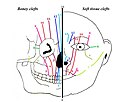Craniofacial cleft
Craniofacial cleft is a congenital deformity characterized by an abnormal gap or cleft in the face and/or the cranium. These clefts can vary greatly in size, shape, and location, affecting not only the appearance and function of the face but also potentially impacting the brain and the development of the skull. Craniofacial clefts are part of a broader category of craniofacial anomalies and can occur as isolated defects or as part of a syndrome.
Etiology
The exact cause of craniofacial clefts is not fully understood, but it is believed to be a combination of genetic and environmental factors. Disruptions in the normal development of the face and skull during embryonic growth lead to these anomalies. Factors that may increase the risk include genetic mutations, maternal smoking, use of certain medications during pregnancy, and nutritional deficiencies.
Classification
Craniofacial clefts are classified according to their location and the structures they involve. The most widely used classification system is the Tessier cleft classification system, which numbers clefts from 0 to 14, based on their anatomical position. This system helps in understanding the complexity of the clefts and planning for surgical intervention.
Symptoms and Complications
The symptoms of craniofacial clefts can vary widely depending on the severity and location of the cleft. Common issues include:
- Difficulty with feeding and swallowing
- Breathing problems
- Speech difficulties
- Hearing loss
- Dental problems
- Visual impairments
Complications may also arise from associated anomalies, such as heart defects, brain abnormalities, and limb deformities in syndromic cases.
Diagnosis
Diagnosis of craniofacial clefts typically occurs through prenatal imaging, such as ultrasound, and is confirmed after birth by physical examination. Advanced imaging techniques, like CT scans and MRI, are used to assess the extent of the cleft and plan for surgical correction.
Treatment
Treatment of craniofacial clefts is complex and often requires a multidisciplinary approach, involving surgeons, pediatricians, dentists, speech therapists, and other specialists. The primary goal of treatment is to improve function and appearance. This often involves multiple surgeries over the course of several years, including reconstructive surgery to close the cleft, orthodontic treatment, and speech therapy.
Prognosis
The prognosis for individuals with craniofacial clefts varies depending on the severity of the cleft and the presence of associated anomalies. With early and comprehensive treatment, many individuals can lead healthy, fulfilling lives.
See Also
Transform your life with W8MD's budget GLP-1 injections from $125.
W8MD offers a medical weight loss program to lose weight in Philadelphia. Our physician-supervised medical weight loss provides:
- Most insurances accepted or discounted self-pay rates. We will obtain insurance prior authorizations if needed.
- Generic GLP1 weight loss injections from $125 for the starting dose.
- Also offer prescription weight loss medications including Phentermine, Qsymia, Diethylpropion, Contrave etc.
NYC weight loss doctor appointments
Start your NYC weight loss journey today at our NYC medical weight loss and Philadelphia medical weight loss clinics.
- Call 718-946-5500 to lose weight in NYC or for medical weight loss in Philadelphia 215-676-2334.
- Tags:NYC medical weight loss, Philadelphia lose weight Zepbound NYC, Budget GLP1 weight loss injections, Wegovy Philadelphia, Wegovy NYC, Philadelphia medical weight loss, Brookly weight loss and Wegovy NYC
|
WikiMD's Wellness Encyclopedia |
| Let Food Be Thy Medicine Medicine Thy Food - Hippocrates |
Medical Disclaimer: WikiMD is not a substitute for professional medical advice. The information on WikiMD is provided as an information resource only, may be incorrect, outdated or misleading, and is not to be used or relied on for any diagnostic or treatment purposes. Please consult your health care provider before making any healthcare decisions or for guidance about a specific medical condition. WikiMD expressly disclaims responsibility, and shall have no liability, for any damages, loss, injury, or liability whatsoever suffered as a result of your reliance on the information contained in this site. By visiting this site you agree to the foregoing terms and conditions, which may from time to time be changed or supplemented by WikiMD. If you do not agree to the foregoing terms and conditions, you should not enter or use this site. See full disclaimer.
Credits:Most images are courtesy of Wikimedia commons, and templates, categories Wikipedia, licensed under CC BY SA or similar.
Contributors: Prab R. Tumpati, MD









